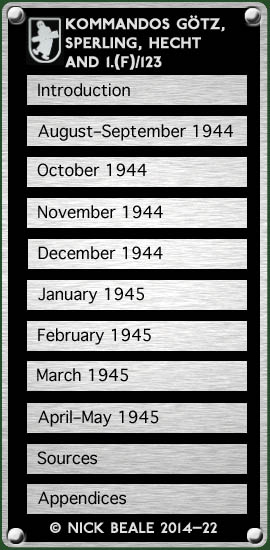|
GH was still the unit's only operational Arado on 1 February but two more arrived during the day: T5+DH and T5+IH which, it seems from strength returns and mission reports, may have been re-marked with the 4U code of 1.(F)/123. This retention of 1.(F)/100 aircraft looks like a straightforward means of addressing Sperling’s lack of serviceable machines at a period when the other Staffel regularly had four ready for operations. Next day “KY+BL” arrived. It seems likely that this was an error for K7+BL, since K7+AL had been with 1.(F)/100 for 10 days or more and K7 was the code of 3./Aufkl.Gr. (Nacht), from which this latest incarnation of 1.(F)/123 had been formed. One of the “borrowed” aircraft, T5+IH, flew Sperling’s only mission of 3 February, Ltn. Viergutz taking off at 11.44 hrs. for a photo-reconnaissance of Nijmegen, Venlo and Roermond. His films were due to be taken away by a dispatch rider at 16.00 hrs. Next day the Kommando’s strength was augmented by a BH and CH, one of which was perhaps KY+BL repainted, while the other was W.Nr. 140464. At least one sortie was flown, from 08.45–09.55 hrs. on the route Nijmegen – Venlo – Roermond – Venray – Mill – Nijmegen – Arnhem. No operations had been flown by mid-afternoon on the 5th. No more cover names? The 6th brought another aircraft, W.Nr. 140460, and the deciphered information that Hptm. Felde had been reported as being the pilot of aircraft 4U+DH of 1.(F)/123. At 02.00 hrs. the following morning, the designations Sonderkommandos Sperling and Hecht were cancelled with immediate effect, in favour of 1.(F)/123 and 1.(F)/100 respectively. The Gen. der Aufklärungsflieger issued orders regarding bases for the constituent parts of the Versuchsverband OKL: 1. Staffel to Kaltenkirchen 2. Staffel to Göttingen (Staffel for flights against the enemy) 3. Staffel to remain in Oranienburg That evening, 1.(F)/123’s tasks for the 8th were communicated by Lw.Kdo. West: (A) P/R strips of course of front line to 10 kms. on enemy side, in sector Roermond – Jülich – Düren – Schmidt – Schleiden. (B) P/R south coast of West Scheldt from Neuzen (inclusive) to Heyst, to determine auxiliary harbours, and also P/R north coast of North Beveland and north coast of Tholen for possible preparations for crossing. (C) Probing recce Humber Estuary with P/R of Hull and recce of London for effects of V [weapons] in accordance with Special Order 1. The T9+GH was ferried Oranienburg during the day, signifying perhaps that its usual pilot, Horst Götz was giving place to Hptm. Felde, the Kapitän of 1.(F)/123. Three sorties were flown:
On the evening of the 7th the Versuchsverband announced that it was to transfer immediately to Kaltenkirchen. A signal of 8 February advised that “VH from Oranienburg” would be landing at 12.25 hrs. but did not say where and neither of the Ar 234 reconnaissance units reported a VH in subsequent strength returns. Activity on 9 February seems to have been confined to a 39-minute meteorological flight from 09.10 hrs. which presumably found unfavourable conditions but at least one aircraft went up the next day:
continued on next page …
|
|||||||||||||

